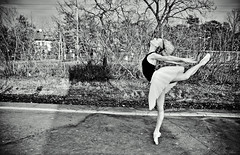 With the recent popularity of the movie, Black Swan, I’ve decided to write about a musculoskeletal condition found in dancers: ankle impingement. You don’t have to be a physical therapist, especially if you have ever watched the ballet, to know that dancers suffer from ankle and foot injuries. Ballet dancers, in particular, have incredible physical demands placed on their feet and ankles, conditioning themselves for their entire lives to be able to withstand the stresses of dancing en pointe. Ankle impingement is a painful condition in which soft tissue structures around the ankle get compressed and pinched, leading to inflammation, pain, and swelling. Abnormal bone growth, anatomy, chronic ankle sprains and instability, and/or arthritis can contribute to this painful condition. Impingement can limit motion at the ankle and a cause loss in range of motion ( ROM ). There are two types of ankle impingement seen in dancers.
With the recent popularity of the movie, Black Swan, I’ve decided to write about a musculoskeletal condition found in dancers: ankle impingement. You don’t have to be a physical therapist, especially if you have ever watched the ballet, to know that dancers suffer from ankle and foot injuries. Ballet dancers, in particular, have incredible physical demands placed on their feet and ankles, conditioning themselves for their entire lives to be able to withstand the stresses of dancing en pointe. Ankle impingement is a painful condition in which soft tissue structures around the ankle get compressed and pinched, leading to inflammation, pain, and swelling. Abnormal bone growth, anatomy, chronic ankle sprains and instability, and/or arthritis can contribute to this painful condition. Impingement can limit motion at the ankle and a cause loss in range of motion ( ROM ). There are two types of ankle impingement seen in dancers.
Anterior Impingement
This condition is manifested as pain on the top (dorsal) and outside (lateral) area of the foot. It is commonly felt with plie or deep squatting.
Posterior Impingement
This condition is felt as pain at the back of the ankle at or above the heel. It is commonly felt with releve or pointing the toes down.
Although ankle impingement is a common dance injury, non-dancers also suffer from this condition. Most commonly, I see patients with anterior ankle impingement secondary to flat feet or chronic ankle sprain. Following ankle sprains, the injured tissues go through a process of healing and remodeling. If not properly rehabilitated or not rehabilitated at all, the tissues will not heal optimally, leading to chronic pain and possibly impingement. Several factors can contribute to ankle impingement, ankle sprain, and flat feet and you should consult with a physical therapist to assess flexibility, movement, and joint mobility if you think you have these conditions. In addition to providing treatment to relieve the pain and inflammation, physical therapists can help to address other contributing physical limitations. You can find a PT here.
Picture credit: “Finale” by CobraVerde on Flickr
References
Robinson, P. (2007). Impingement syndromes of the ankle. European Radiology, 17(12), 3056.
Common Dance Injuries – Foot/Ankle. (n.d.). . Retrieved January 16, 2011, from http://www.med.nyu.edu/hjd/harkness/patients/injuries/foot.html#posterior










January 17, 2011
General Information